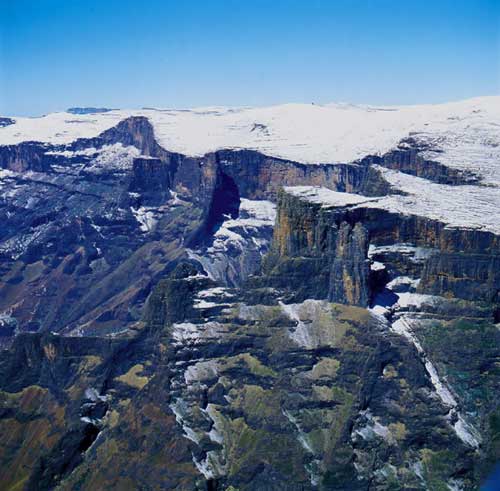Highest Summits
The highest peaks of southern Africa rise to above 3300 meters and are all found within the Maloti-Drakensberg Park. This region forms a jagged border between South Africa and the kingdom of Lesotho. Some peaks are shared between the two countries, as the border runs over the summits. Most of these peaks form part of the main escarpment of the Drakensberg and the watershed in this area.
Climbing the Highest Mountain in South Africa
The whole Maloti Drakensberg Park is a favourite hiking and climbing area for South Africans and overseas visitors. Most of the highest peaks are accessible on foot. Of the nine highest within South Africa, only two require technical climbing to reach the summit. The entire park is a UNESCO World Heritage Site and has been preserved for it’s fauna and flora and cultural history.
The very highest peak in the area is Thabana Ntlenyana – It stands at 3482m (11 424ft) above sea level. It’s name means “nice little mountain” and it is a very insignificant flat topped mountain about four kilometers inside Lesotho and a half day walk from the top of Sani Pass. It is also the highest peak in Africa south of Mt. Kilimanjaro. The next highest peak is Makeka at 3462m, followed by Thaba Putsoa at a height of 3455m. These three peaks are all in Lesotho.

Mafadi, SA’s highest mountain, seen on the extreme right of the picture.
Within South Africa, the highest point is Mafadi peak, rising to 3450m (11 322ft) above sea level. It lies on the border with Lesotho in the Injisuthi area. A new survey, done in 2002, shows that its height is actually 3451 meters. The Sotho name for the peak is Ntheleli. It too is a very insignificant looking, flat topped mountain. Adjoining Mafadi is Injisuthi Dome (3410m) Injisuthi means “the well fed dog” in the Zulu language. There are several spellings of the word, including Njasuti and Injasuthi.
The third highest peak in South Africa is Champagne Castle (3377m) which is a little west of Monk’s Cowl and forms the edge of the escarpment in this area. Then there is Giant’s Castle (3314m), a very prominent peak that juts 3 kilometers out into South Africa and is easily seen from the KZN Midlands. The Zulu name is Ntabayikonjwa and means “the one at which you must not point”. This apparently has something to do with a Zulu belief to not point at a giant.
Number five on the list of highest peaks in South Africa is the Long Wall (3260m). As the name indicates, it is a long and shear wall of rock just north of Giant’s Castle. Number six is Monk’s Cowl at 3229m. It is the highest free standing peak and the highest peak that requires rock climbing to reach the summit.
Then seventh is Injisuthi Lesser Buttress (3212m). It is a buttress which lies on the escarpment edge near Injasthu Dome. This is followed by its neighbour, Injisuthi Greater Buttress (3202m). The ninth highest peak is Mponjwana (3177m) which is also only attainable by means of technical rock climbing. This peak is in the Mweni area in the north of the Drakensberg range. The name means the small horn of a young cow. The peak is in fact incorrectly named – Cathedral Peak should be called Mponjwana. This name change/mistake came about by accident by early map makers.
References:
* South African Survey General
* Thomas Wimber MCSA Journal 1999
* The Drakensberg of Natal Doyle Liebenberg
* Barrier of Spears R.O. Pearse
 Follow
Follow